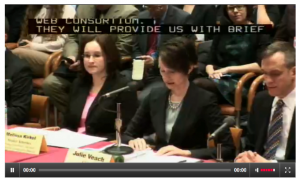Nancy Buckley knows all too well the ill effects of bad air. In the past year, the 44-year-old has been hospitalized three times due to severe asthma attacks.
“It’s like somebody sticking a pillow over you and you’re trying to breathe through it,” said Buckley, who lives on the North Side of Chicago. “Treatments at the hospital are the only thing that helps.”
For years, Buckley and other Cook County residents have been breathing some of the worst air in the nation. That could change with a new regulation set last month by the U.S. Environmental Protection Agency strengthening air quality standards for nitrogen dioxide, a main offender of urban air pollution.
Currently, Cook County is the only county nationwide failing to meet the new regulation. But others could join the county when revised monitoring requirements lead to a greater number of sites being monitored.
“I suspect once the monitors are up and running, there will be more areas than Cook County,” said Doug Aburano, environmental engineer with the U.S. EPA’s downtown office.
Nitrogen dioxide, or NO2, is a pollutant from cars, trucks, and burning coal, oil or natural gas, as well as power plants and boilers. It can trigger asthma and bronchitis attacks, and elevated NO2 levels are associated with increased airway reactivity, worsened asthma and increases in respiratory illnesses and symptoms. The agency says the new rule will protect public health, including those with asthma, children and the elderly.
Aburano said the older standard is not protective of human health for those with and without breathing problems. Yet some clean air advocates say the new standard still is not tight enough.
“U.S. EPA was looking at a range of options for setting the NO2 standard, and unfortunately they picked the absolute weakest option,” said Brian Urbaszewski, director of environmental health programs for the Respiratory Health Association of Metropolitan Chicago.
Chicago is an “asthma epicenter” with an asthma hospitalization rate nearly double the national average, Urbaszewski said. He said some new medical research on NO2 was not considered in the EPA decision, and research published two months ago indicated breathing nitrogen dioxide NO2 diminishes the effectiveness of medicine in asthma inhalers, rendering rescue inhalers less able to counter effects of an asthma attack. Higher NO2 levels were also correlated to more senior citizens developing pneumonia in another recent study.
“Changing the air quality standard is not going to make air pollution better or worse, it’s only changing the yardstick we use to measure whether air pollution levels are unhealthy,” Urbaszewski said. “If it’s set too low, or we fail to measure air pollution where we know it’s highly concentrated—near major roads—then people aren’t going to get accurate information they can use to protect themselves.”
If in violation of the new standards, a state will have to develop a plan to reduce emissions so the level in the environment will be below standards. This means coming up with enough emission reductions so that it no longer exceeds that air pollution number. This can be done by setting up new programs, enacting new industrial rules and requiring new pollution controls on big polluters, Urbaszewski said.
Meanwhile, Buckley said she’ll take a wait-and-see attitude to see if the tighter regulation makes a difference in the way she breathes.
“We’ll see how it works out,” she said. “But it’s definitely a good start.”

![Reblog this post [with Zemanta]](http://img.zemanta.com/reblog_c.png?x-id=a24b363a-db91-4cae-9db0-13db46c4f79f)










Be First to Comment